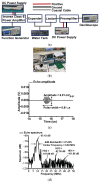An Inverse Class-E Power Amplifier for Ultrasound Transducer
- PMID: 37050526
- PMCID: PMC10098776
- DOI: 10.3390/s23073466
An Inverse Class-E Power Amplifier for Ultrasound Transducer
Abstract
An inverse Class-E power amplifier was designed for an ultrasound transducer. The proposed inverse Class-E power amplifier can be useful because of the low series inductance values used in the output matching network that helps to reduce signal distortions. Therefore, a newly designed Class-E power amplifier can obtain a proper echo signal quality. The measured output voltage, voltage gain, voltage gain difference, and power efficiency were 50.1 V, 22.871 dB, 0.932 dB, and 55.342%, respectively. This low voltage difference and relatively high efficiency could verify the capability of the ultrasound transducer. The pulse-echo response experiment using an ultrasound transducer was performed to verify the capability of the proposed inverse Class-E power amplifier. The obtained echo signal amplitude and pulse width were 6.01 mVp-p and 0.81 μs, respectively. The -6 dB bandwidth and center frequencies of the echo signal were 27.25 and 9.82 MHz, respectively. Consequently, the designed Class-E power amplifier did not significantly alter the performance of the center frequency of the ultrasound transducer; therefore, it could be employed particularly in certain ultrasound applications that require high linearity and reasonable power efficiency.
Keywords: inverse Class-E power amplifier; ultrasound system; ultrasound transducer.
Conflict of interest statement
The authors declare no conflict of interest. The funders had no role in the study design; collection, analyses, or interpretation of data; writing of the manuscript; or the decision to publish the results.
Figures










References
-
- Suri J.S., Kathuria C., Chang R.-F., Molinar F., Fenster A. Advances in Diagnostic and Therapeutic Ultrasound Imaging. Artech House; Norwood, MA, USA: 2008.
-
- Postema M. Fundamentals of Medical Ultrasound. Taylor and Francis; New York, NY, USA: 2011.
Grants and funding
LinkOut - more resources
Full Text Sources
Miscellaneous

